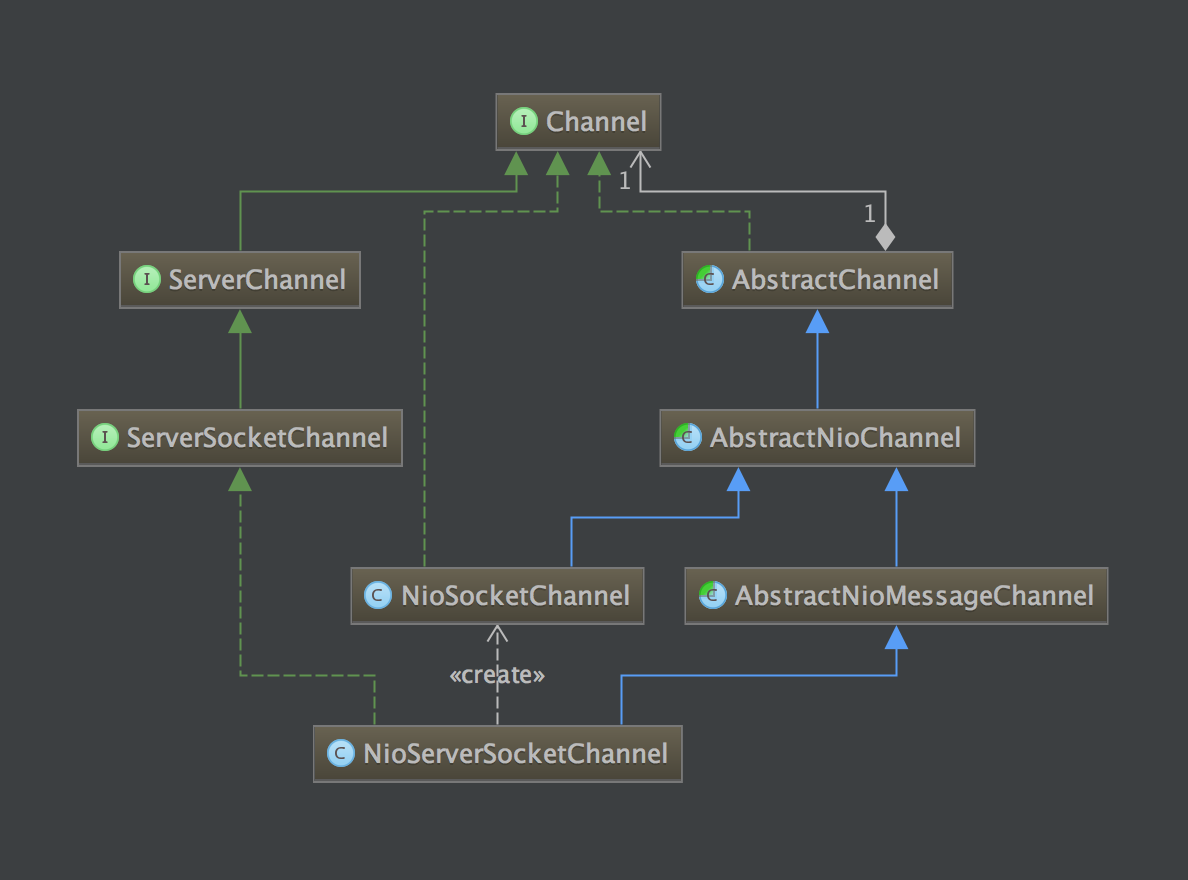Channel的功能
基本的 I/O 操作(bind()、connect()、read()和 write())依赖于底层网络传输所提 供的原语。在基于 Java 的网络编程中,其基本的构造是 class Socket。Netty 的 Channel 接 口所提供的 API,大大地降低了直接使用 Socket 类的复杂性。此外,Channel 也是拥有许多 预定义的、专门化实现的广泛类层次结构的根,下面是一些Channel的类型:
- EmbeddedChannel
- LocalServerChannel
- NioDatagramChannel
- NioSctpChannel
- NioSocketChannel
io.netty.channel.Channel 是 Netty 网络操作抽象类,它聚合了一组功能,包括但不限于网络的读、写,客户端发起连接、主动关闭连接,链路关闭,获取通信双方的网络地址等。
它也包含了Netty框架相关的一些功能,包括获取该 Chanel的EventLoop,获取缓冲分配
器 ByteBufAllocator 和 pipeline 等。
Channel的工作原理
Channel 是 Netty 抽象出来的网络I/O读写相关的接口,为什么不使用 JDK NIO 原生的 Channel 呢,主要原因如下:
- JDK 的 SocketChannel 和 ServerSocketChannel 没有统一的 Channel 接口供业务幵
发者使用,对于用户而言,没有统一的操作视图,使用起来并不方便; - JDK 的 SocketChannel 和 ServerSocketChannel 的主要职责就是网络I/O操作,由
于它们是SPI类接口,由具体的虚拟机厂家来提供,所以通过继承SPI功能类来扩展其功
能的难度很大;直接实现 ServerSocketChannel 和 SocketChannel 抽象类,其工作量和重新
幵发一个新的 Channel 功能类是差不多的; - Netty 的 Channel 需要能够跟 Netty 的整体架构融合在一起,例如I/O模型、基于
ChannelPipeline 的定制模型,以及基于元数据描述配置化的TCP参数等,这些 JDK 的
SocketChannel 和 ServerSocketChannel 都没有提供,需要重新封装; - 自定义的Channel,功能实现更加灵活。
基于上述4个原因,Netty 重新设计了 Channel 接口,并且给予了很多不同的实现。
它的设计原理比较简单,但是功能却比较繁杂,主要的设计理念如下:
- 在Channel接口层,采用Facade模式进行统一封装,将网络I/O操作、网络I/O相关联的其他操作封装起来,统一对外提供;
- Channel 接口的定义尽量大而全,为 SocketChannel 和 ServerSocketChannel 提供统一的视图,由不同子类实现不同的功能,公共功能在抽象父类中实现,最大程度上实现功能和接口的重用;
- 具体实现采用聚合而非包含的方式,将相关的功能类聚合在 Channel 中,由 Channel 统一负责分配和调度,功能实现更加灵活。
Channel的继承关系
下面是 Netty 中 Channel 的继承关系:

AbstractChannel
我们看下AbstractChannel定义的变量:
|
|
这里聚合了Channel、Unsafe、DefaultChannelPipeline和EventLoop,这里的parent变量对应ServerSocketChannel类型,每个Channel还需要一个Unsafe对象来进行实际的IO读写操作。
Netty对IO的处理要经过PipeLine来进行,而任务的执行是在EventLoop中进行的,所以,一个Channel对应一个PipeLine和一个EventLoop。
我们看下一些方法的实现:
|
|
可见,所有的网络IO操作都交给了pipeLine,由添加到pipeLine中的ChannelHandler来执行具体的处理。
AbstractNIOChannel
我们看下在AbstractNioChannel中定义的一些成员变量:
|
|
这里聚合了一个SelectableChannel类型的变量ch,因为SocketChannel和ServerSocketChannel需要共用。
readInterestOp默认设置的值是SelectionKey的OP_READ。
定义了一个SelectionKey对象,保存该Channel注册到selector后的返回键。
最后定义了表示连接结果的ChannelPromise以及超时的定时器和需要请求的通信地址。
下面我们看下AbstractNIOChannel中执行注册的方法:
|
|
这里的死循环要确保注册成功,如果此通道当前已注册到给定的选择器,但相应的键已被取消,那么会抛出CancelledKeyException。
该方法定义了一个selected变量表示是否执行了select方法,如果发生了CancelledKeyException,那么执行eventLoop().selectNow(),因为如果Select.select(..)方法没有被调用时,被取消的SelectionKey可能还会缓存在selector中没有被删除。这时设置selected的值为true表示已经调用过Select.select(..)方法了。
如果这时selected变量为true,再次执行循环时又发生了CancelledKeyException,则说明执行了select方法后,SelectionKey还存在于selector中,这可能就触发了JDK中的BUG,直接抛出异常。
下面的doBeginRead方法在 Channel.read() 或者 ChannelHandlerContext.read() 调用的时候被调用,将readPending设置为true,同时将selectionKey增加可读的操作:
|
|